| Listing 1 - 10 of 15 | << page >> |
Sort by
|
Book
ISBN: 0810111225 Year: 1996 Publisher: Evanston, Ill. Northwestern University Press
Abstract | Keywords | Export | Availability | Bookmark
 Loading...
Loading...Choose an application
- Reference Manager
- EndNote
- RefWorks (Direct export to RefWorks)
Book
ISBN: 3727806990 Year: 1990 Publisher: Freiburg Universitätsverl.
Abstract | Keywords | Export | Availability | Bookmark
 Loading...
Loading...Choose an application
- Reference Manager
- EndNote
- RefWorks (Direct export to RefWorks)
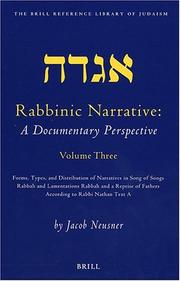
ISBN: 9789004494541 9789004130357 Year: 2003 Publisher: Leiden; Boston : BRILL
Abstract | Keywords | Export | Availability | Bookmark
 Loading...
Loading...Choose an application
- Reference Manager
- EndNote
- RefWorks (Direct export to RefWorks)
Each Rabbinic document, from the Mishnah through the Bavli, defines itself by a unique combination of indicative traits of rhetoric, topic, and particular logic that governs its coherent discourse. But narratives in the same canonical compilations do not conform to the documentary indicators that govern in these compilations, respectively. They form an anomaly for the documentary reading of the Rabbinic canon of the formative age. To remove that anomaly, this project classifies the types and forms of narratives and shows that particular documents exhibit distinctive preferences among those types. This detailed, systematic classification of Rabbinic narrative supplies these facts concerning the classification of narratives and their regularities: [1] what are the types and forms of narrative in a given document? [2] how are these distinctive types and forms of narrative distributed across the canonical documents of the formative age, the first six centuries C.E.? The answers for the documentary preferences are in Volumes One through Three, for the Mishnah-Tosefta, the Tannaite Midrash-compilations, and Rabbah-Midrash-compilations, respectively. Volume Four then sets forth the documentary history of each of the types of Rabbinic narrative, including the authentic narrative, the ma'aseh and the mashal. How the traits of the several types of narratives shift as the respective types move from document to document is spelled out in complete detail. This project opens an entirely new road toward the documentary analysis of Rabbinic narrative. It fills out an important chapter in the documentary hypothesis of the Rabbinic canon in the formative age.
Book
Year: 1980 Publisher: Wiesbaden Fourier
Abstract | Keywords | Export | Availability | Bookmark
 Loading...
Loading...Choose an application
- Reference Manager
- EndNote
- RefWorks (Direct export to RefWorks)
Symbolism --- Midrash --- -Parables in rabbinical literature --- Wisdom --- -Legends --- Religious aspects --- -Judaism
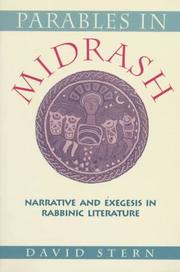
ISBN: 0674654471 067465448X Year: 1994 Publisher: Cambridge Harvard university press
Abstract | Keywords | Export | Availability | Bookmark
 Loading...
Loading...Choose an application
- Reference Manager
- EndNote
- RefWorks (Direct export to RefWorks)
Midrash --- Narration in rabbinical literature --- Parables in rabbinical literature --- History and criticism
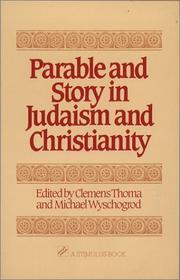
ISBN: 0809130874 Year: 1989 Publisher: New York (N.Y.): Paulist
Abstract | Keywords | Export | Availability | Bookmark
 Loading...
Loading...Choose an application
- Reference Manager
- EndNote
- RefWorks (Direct export to RefWorks)
Parables in rabbinical literature --- Parables --- Storytelling --- Religious aspects --- Jesus Christ --- Parables
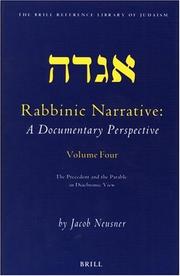
ISBN: 9789004493926 9789004130364 Year: 2003 Publisher: Leiden; Boston : BRILL
Abstract | Keywords | Export | Availability | Bookmark
 Loading...
Loading...Choose an application
- Reference Manager
- EndNote
- RefWorks (Direct export to RefWorks)
Each Rabbinic document, from the Mishnah through the Bavli, defines itself by a unique combination of indicative traits of rhetoric, topic, and particular logic that governs its coherent discourse. But narratives in the same canonical compilations do not conform to the documentary indicators that govern in these compilations, respectively. They form an anomaly for the documentary reading of the Rabbinic canon of the formative age. To remove that anomaly, this project classifies the types and forms of narratives and shows that particular documents exhibit distinctive preferences among those types. This detailed, systematic classification of Rabbinic narrative supplies these facts concerning the classification of narratives and their regularities: [1] what are the types and forms of narrative in a given document? [2] how are these distinctive types and forms of narrative distributed across the canonical documents of the formative age, the first six centuries C.E.? The answers for the documentary preferences are in Volumes One through Three, for the Mishnah-Tosefta, the Tannaite Midrash-compilations, and Rabbah-Midrash-compilations, respectively. Volume Four then sets forth the documentary history of each of the types of Rabbinic narrative, including the authentic narrative, the ma'aseh and the mashal. How the traits of the several types of narratives shift as the respective types move from document to document is spelled out in complete detail. This project opens an entirely new road toward the documentary analysis of Rabbinic narrative. It fills out an important chapter in the documentary hypothesis of the Rabbinic canon in the formative age.

ISBN: 9004130357 9004494545 142372965X 9781423729655 Year: 2003 Volume: 16 3 Publisher: Leiden, The Netherlands ; Boston : Brill,
Abstract | Keywords | Export | Availability | Bookmark
 Loading...
Loading...Choose an application
- Reference Manager
- EndNote
- RefWorks (Direct export to RefWorks)
Each Rabbinic document, from the Mishnah through the Bavli, defines itself by a unique combination of indicative traits of rhetoric, topic, and particular logic that governs its coherent discourse. But narratives in the same canonical compilations do not conform to the documentary indicators that govern in these compilations, respectively. They form an anomaly for the documentary reading of the Rabbinic canon of the formative age. To remove that anomaly, this project classifies the types and forms of narratives and shows that particular documents exhibit distinctive preferences among those types. This detailed, systematic classification of Rabbinic narrative supplies these facts concerning the classification of narratives and their regularities: [1] what are the types and forms of narrative in a given document? [2] how are these distinctive types and forms of narrative distributed across the canonical documents of the formative age, the first six centuries C.E.? The answers for the documentary preferences are in Volumes One through Three, for the Mishnah-Tosefta, the Tannaite Midrash-compilations, and Rabbah-Midrash-compilations, respectively. Volume Four then sets forth the documentary history of each of the types of Rabbinic narrative, including the authentic narrative, the ma'aseh and the mashal. How the traits of the several types of narratives shift as the respective types move from document to document is spelled out in complete detail. This project opens an entirely new road toward the documentary analysis of Rabbinic narrative. It fills out an important chapter in the documentary hypothesis of the Rabbinic canon in the formative age.
Book
ISBN: 1463222815 9781463222819 Year: 2010 Publisher: Piscataway, NJ : Gorgias Press,
Abstract | Keywords | Export | Availability | Bookmark
 Loading...
Loading...Choose an application
- Reference Manager
- EndNote
- RefWorks (Direct export to RefWorks)
The Rabbis’ King-Parables: Midrash From the Third-Century Roman Empire examines the ancient Rabbis at work using parables about kings; parables that reflect the Rabbis' ideas about the role of the ruler in society, and the relationship of humanity to God. It considers the parables as resistance literature in light of the work of theorists of dominated groups. It is the first systematic attempt to read the parables as sources for Roman history in over 100 years.
Parables in rabbinical literature. --- Kings and rulers in rabbinical literature. --- Midrash --- Jews --- Judaism --- God (Judaism) --- History and criticism. --- History --- Love --- Jesus Christ --- Parables. --- Rome --- Palestine
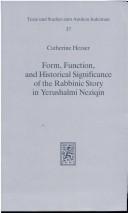
ISSN: 07218753 ISBN: 3161461487 9783161461484 Year: 1993 Volume: 37 Publisher: Tübingen Mohr Siebeck
Abstract | Keywords | Export | Availability | Bookmark
 Loading...
Loading...Choose an application
- Reference Manager
- EndNote
- RefWorks (Direct export to RefWorks)
Narration in rabbinical literature --- Parables in rabbinical literature --- Talmud Yerushalmi --- Criticism, interpretation, etc --- 296*23 --- Rabbinical literature --- Narration (Rhetoric) --- Talmudcommentaren --- 296*23 Talmudcommentaren --- Narration in rabbinical literature. --- Parables in rabbinical literature. --- Talmud Yerushalmi. --- Criticism, interpretation, etc. --- Nezikin (Talmud Yerushalmi) --- Neziqin (Talmud Yerushalmi)
| Listing 1 - 10 of 15 | << page >> |
Sort by
|

 Search
Search Feedback
Feedback About
About Help
Help News
News